
| extended search | |||
|
|
When Everybody Called
Me Gabe-bines,
|
"This project has been financed in part with funds provided by the State of Minnesota from the Arts and Cultural Heritage Fund through the Minnesota Historical Society." "This publication was made possible in part by the people of Minnesota through a grant funded by an appropriation to the Minnesota Historical Society from the Minnesota Arts and Cultural Heritage Fund. Any views, findings, opinions, conclusions or recommendations expressed in this publication are those of the authors and do not necessarily represent those of the State of Minnesota, the Minnesota Historical Society, or the Minnesota Historic Resources Advisory Committee." |
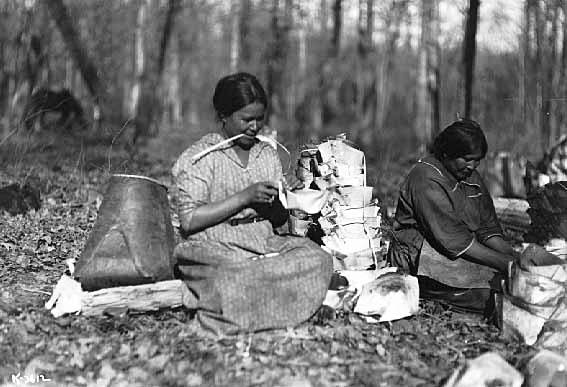 Mary Bigwind and Maggie Skinaway making birch bark containers for maple sap, ca. 1930. Photographer: Kenneth Melvin Wright Photograph Collection, ca.1930 Collections Online Minnesota Historical Society Location No. E97.34 p4 Negative No. 4995-A |
|
My mother, my sister Mary and I left Bena toward the very end of winter to join my father's family for the spring move to the sugar bush, our maple sugar-making site. In Indian my people call that sugar bush Iskigamizigan, our "place of reducing maple sap to sugar by boiling."(1) |
When spring came almost everyone moved to a sugar bush. Someone -- maybe a scout(2) -- knew where the sugar maples grew best, and most went sugaring in these places. Some wanted to go this way, and some that way, to certain parts of the sugar bush. So from their winter camps(3) the Indians split up like that. Then after sugar they moved again.(4) Sugaring was my favorite time of the year. It was everybody's favorite
time, and each year, towards the end of winter, we all waited for its
signs.
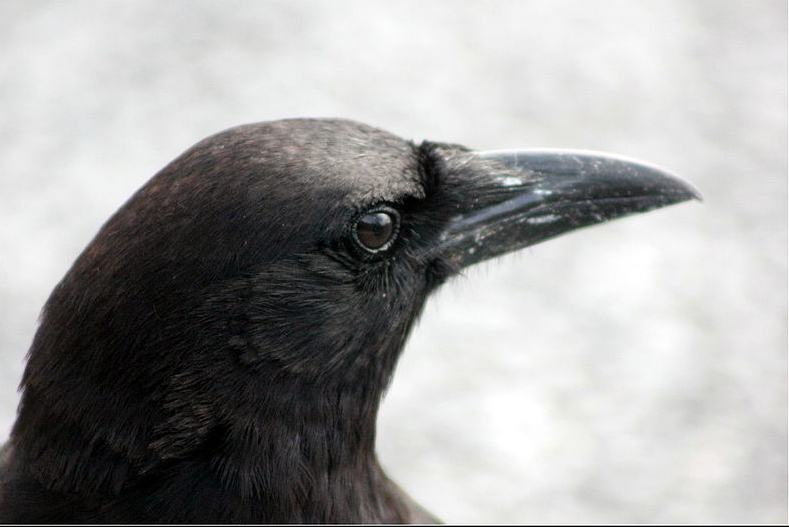 American Crow. (Corvus brachyrhynchos) Wikimedia xxx Original file (5,234 × 3,506 pixels, file size: 2.45 MB, MIME type: image/jpeg); 800 × 536 pixels The first signs of spring are the crows, the aandegwag. When they come, the crows signal that warmer weather is coming. You hear a crow or see a crow, and you know that's the first sign that it's turning warmer. That's why they come back. The crows don't come back from Minneapolis or somewhere just for the heck of it. They used to go as far as Minneapolis, but now they go farther on account of the deep snow, I suppose. The crows come early because they want to know how far they can go. If it's mild, the summer birds come pretty fast too, with ducks coming in after the crows, maybe. When the river opens the ducks come in. See, there's something they know about the weather too. It's natural. Anyway, the first sign of spring that we notice is the crow, and when we see a crow we think to ourselves, "Well, that's a sure sign. But don't feel that the winter is over, because there's a great cold weather that's going to try the crow out. A great cold is going to see how much he could stand." So it gets cold ten days afterwards -- generally at ten days after. Then the crows go back, and you don't see them for a few days. There are different parts of the weather. The Indians watch the animals and the weather, and they read the moon. And they can feel what the weather is going to be. The Indian can feel it, especially the summer-born.(5) We believe in signs. I told you this before. And we believe in signs releasing us from the campground. So if we felt the great cold would come again in ten days we'd wait ten days before moving our winter camp. Then, ten days after, the weather'd begin to cut loose. You notice that yourself. If you wait for ten days you'll generally see a cold spell coming behind that first nice weather. I've seen the crow up here in the north as early as the second of
February, but that was a mild winter. The normal, the regular time for
him to come, is about the twentieth of March. If we saw the crow on the
twentieth of March, we would leave for the sugar camp about the last of
March. 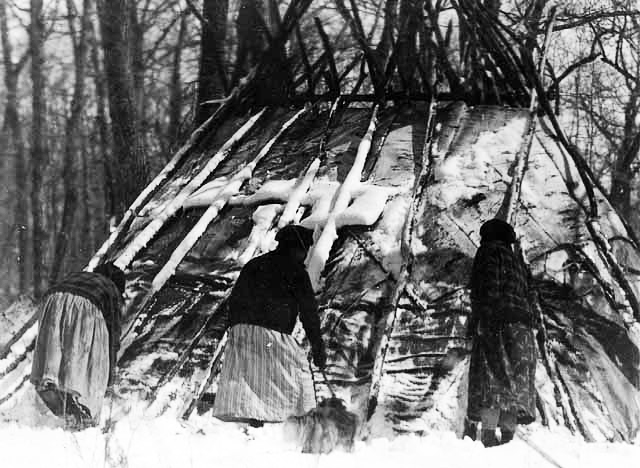 Women building maple sugar lodge, Mille Lacs Indian Reservation, ca. 1925. Photograph Collection, ca. 1925 Collections Online Minnesota Historical Society Location No. E97.31 r33 Negative No. 6959 When they first saw the crow, the adults would start preparing for the spring. They'd prepare by talking about where they should move. Maybe they'd want to move back to their reservation, or maybe to their area where they usually lived in the spring season. If the group had original campers(6) going to the sugar bush with them, these original campers -- the older class -- wanted to go where they usually went, and the younger ones would go wherever the older class camped.
We saved our maple sugar equipment year after year. We put it in a certain place at our sugar bush, in a special bark warehouse used only for sap gathering and processing equipment, so it was always much easier to go back to the same place one sugar season after the next. We'd usually go to the old sugar bush where we were before so we didn't have to make all new sap-gathering baskets. Almost every year we'd go back to the same camp because our tools were there. We just covered up the tools in the warehouse wiigwaam and left them there. The adults would clean up the wiigwaam, clean up the tools, and clean up the birch bark baskets before they stored them, because some of them attract animals. Even then, sometimes a bear would get in there and crack the baskets, so the adults always prepared some new baskets and other necessities before we moved to the sugar bush. 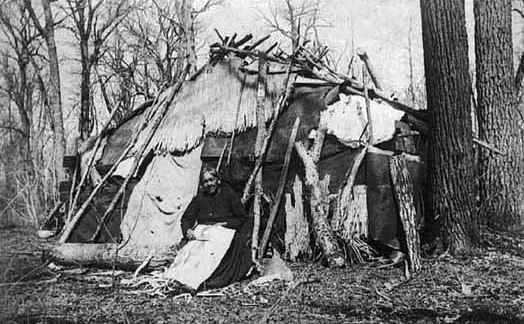 Exterior of sugar camp on an Indian reservation, 1890. Photograph Collection, 1890 Collections Online Minnesota Historical Society Location No. E99.31 r21 Negative No. 45535 During the winter, toward the early part of spring, they began making these new baskets. At this time, along towards March, we'd be anxious to go to our sugar bush. March is a month where you can walk anywhere on snowshoe without having any trouble. That's why we call March Onaabani-giizis, the "moon of walking on top of the snow because it freezes."
It's easy to get around then so most generally, toward the middle of March, some of the adults would haul many of our things to the sugar bush. If they had too much of a load to carry on a single trip to the spring camp they'd decide, "Well, this stuff that we've got for winter use should be hauled first." So they'd take the heaviest and bulkiest part of the load first, like the spare birch and ash bark roofing, kettles, baskets, and all of our sugar-making necessities that they hadn't stored there the year before. They'd haul the new baskets and the other equipment to the sugar bush on simple toboggans, usually cutting across country. We had toboggans made out of brush. These were made from brush tied together. When making the first trip to the sugar bush they put their stuff on the brush, and went without wasting the time to build a better toboggan. They did that because they were going to leave that toboggan anyhow when they'd get where they were going on the end of the journey. They probably just put it away in the brush. They weren't going to save it because it was just brush tied together. But they'd keep the snowshoes and equipment of camping. I've seen them.(7) They'd haul the heaviest load to the sugar bush while the ice was
still frozen, but we waited for the river to open before we moved our
camp. The river rips open fast in mild weather and good weather. Some
of them stayed there at the sugar bush and got ready for sugar camp because
we had to have everything ready by the end of March. The stayers would
start cutting wood, piling the wood. They would prepare the necessities
for making sugar and syrup. They would start to fix up the old birch bark
baskets.
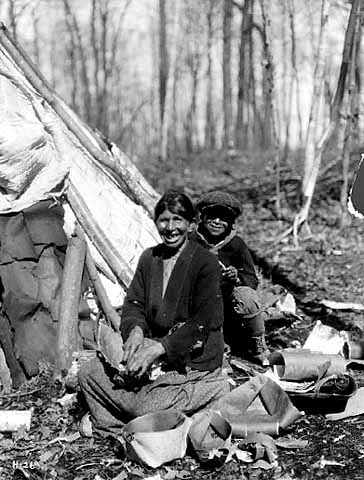 Mrs. Waabooz and son, Jess, making birch bark containers for sap, 1925. Photograph Collection, 1925 Collections Online Minnesota Historical Society Location No. E97.34 p16 Negative No. 40143 We collected maple sap in baskets, little birch bark baskets. They don't leak. If they did leak, we'd patch them up with pitch. The stayers at the sugar bush would patch up the old baskets. Sometimes when we were making, or transporting, or storing the baskets, they would crack. The baskets generally became cracked a little bit so they graded them to see which would hold water, hold sap. They'd take the damaged ones and put them aside to work on while waiting for the others to move the winter camp.
They had pitch to fix them. In the spring they'd melt pitch and patch up the birch bark baskets. They'd get a balsam -- but I think spruce is the best -- and take some pitch. They always had timber -- lots of great spruce, blue spruce. They used bigiw, those big wads of gum that are on the outside of the trees. And if the trees didn't have those wads they'd boil the pitch out. A big wad of pitch, or a little boiling, will make a lot of it. That warm pitch is soft, and when it becomes dry it hardens. That's what they used to patch the birch bark baskets. Sometimes, if the cracks were too bad, they'd put another piece of bark on top of the old and patch them up so they were just as good as new. There was no taste in the pitch. When it dried, its surface was just as good as the bark. It held firm together. They used that pitch to patch all of their bark things. They'd melt that, and smear it on, and leave it cool off. They crystalized it. That pitch crystalizes after it cools off. With that pitch on, there was a good basket for sap.
They had hundreds of baskets -- as high as five hundred to a thousand baskets. Some of them patched up five hundred baskets. That was just enough so they could handle it, and by the time the others of their group got to the sugar bush everything was already made. They were planned ahead.
While some were at sugar bush preparing and repairing houses and equipment, we would keep the wiigwaam at the winter camp. We still kept the winter wiigwaam for a week or ten days after the crows first came. Then, after the cold would break loose again, and when the warm weather came the second time, we'd move everything to the spring camp. We didn't take long to get our camping outfit ready to go to spring camp because we had to be there when the sap started running. If you're there a little bit late, you may be a little too late. Sometimes there's a short season for the sugar, and sometimes there's a long season. It all depends on the cold nights and the amount of moisture in the ground. So when we started moving, we quickly moved our material out to the sugar bush. When it became spring, all of those that wanted to go to the sugar bush move their camps to the hardwood maple country. On our wiigwaams and tipis in those days we used bark sheets,
which made a good solid covering.(8) These
barks were made from birch, cedar, and ash. There was plenty of timber
along the river, especially ash. Ash made a good shelter. Ash made a good
roofing; it's sturdy. Ash made good mats. Ash made good poles. The poles
of a wiigwaam were ash, and we used the bark over those ash poles.
The older class prepared this bark while the timber was in sap. When it
was in sap they cut the top and the bottom of a bark tree to get bark
sheets about six feet in lengths. Some of them cut the bark in four-foot
lengths -- it all depended on what they wanted. Four-foot lengths were
better to handle. It was much easier to handle in four-foot lengths. The
bark was more flexible in shorter lengths, and fit where it belonged.
They cut the bark trees around at the top and at the bottom of the sheet they wanted. Then they split that bark lengthwise between where it was carved around, and it wasn't long before they shoved a blade in there to peel that bark off. The bark came off very easy with the sap running. Oh, I say that the tree might be eighteen inches across. The timber was big them days. When we moved to our seasonal camps we rolled up those barks sheets
and took them with us. We had enough sheets for all of our shelters, and
some extras in storage.
When it was time to move, all we had to do was carry those bark rolls to the new campsite. Each and every one grabbed a roll, some of them grabbed two, three, rolls or whatever they could carry, and they'd carry them on their backs to the campsite where they wanted to camp. The siding and the roofing wasn't very heavy, but it was awkward. Some of the sheets being about six feet long, it was rather awkward to carry them in the brush. I used to hear the adults going through the brush with those rolls
getting to the campsite. You'd often see three or four of them packing
that. I've seen them when they pack that roofing. Sometimes groups moved
seven or eight miles cross-country. They crossed the country to the sugar
bush where they had their camps built up prepared for camping. Some of
them traveled by canoes.
One boat of a family group(9) was a big canoe. We called that chi-wiigwaasi-jiimaan. It was bigger than a passenger canoe, wiigwaasi-jiimaan. That chi- on there makes it big. We had big canoes. You know what that big canoe was for? To move the camping outfit; to move the necessary equipment for camping. Men paddled that big canoe. The passenger canoes, the family canoes, were a different size again. They were small. There were all kinds and sizes of canoe. That's no idea; I've seen that.
However they travelled to the sugar bush, when they got the big bark sheets there they would unroll them and put them on the ash wiigwaam framework. The framework was left there from season to season, and by the time they arrived it had been readied by the parties who had gone on ahead.
Footnotes 1. See Ch. 7, "Skigamizigewin, Maple Sugar Time." Cf., Ch. 18, "Late-Autumn-Winter Camp." 2. See Ch. 4, "Siouxs and Scouts." 3. See Ch. 17, "Winter Wood and Wiigwaams," and Ch. 18, "Late-Autumn-Winter Camp." 4. See Ch. 8, "Old Gardens and New Bark." 5. For a discussion of summer-born vs. winter-born see Ch. 1, "Early Life at Leech Lake," and Ch. 18, "Late-Autumn-Winter Camp." 6. Elderly people who have always lived by camping and moving seasonally. 7. It's quite frequent to indicate whether you've actually seen something, or whether you just heard about it, whether it is part of the basic recurring aspects of nature, or whether it is so ipso facto. If an event is part of a seasonal cyclical event which occurs regularly and inevitably as a part of the natural order, then one will assert that the event happens. If it is part of something like Natural Law -- like gravity causes things to fall, or like the known fact that "3 + 3 = 6" -- then one will assert the existence of the fact or event as a truism. Events which are not inevitably and obviously part of a natural cycle of some kind, or which are not a self-evident truth or known fact, and/or which have not been personally witnessed, are usually (in English) just suggested to occur. 8. See Ch. 17, "Winter Wood and Wiigwaams." Cf., Ch. 8, "Old Gardens and New Bark." 9. Cf. Ch. 3, "Canoe Days." |
| to top of page / A-Z index |
This site is under construction. Comments  E-mail comments
to troufs@d.umn.edu E-mail comments
to troufs@d.umn.edu The University of Minnesota Copyright: © 1997 - 2021 Timothy G. Roufs |
The views and opinions expressed in this page are strictly
those of the page author ![]() .
.
The contents of this page have not been reviewed or approved by the University
of Minnesota.
Page URL:http://www.d.umn.edu /cla/faculty/troufs/Buffalo/PB06.html
Last Modified
Saturday, 02-Feb-2019 20:18:45 CST
Department of Studies in Justice, Culture, & Social Change ![]()
College of Arts, Humanities, and Social Science ![]()
215 Cina Hall ![]()
University of Minnesota Duluth (maps) ![]()
Duluth, MN 55812 - 2496 (maps) ![]()
Gitchee-Gumee
Live ![]()
| to top of page / A-Z index |